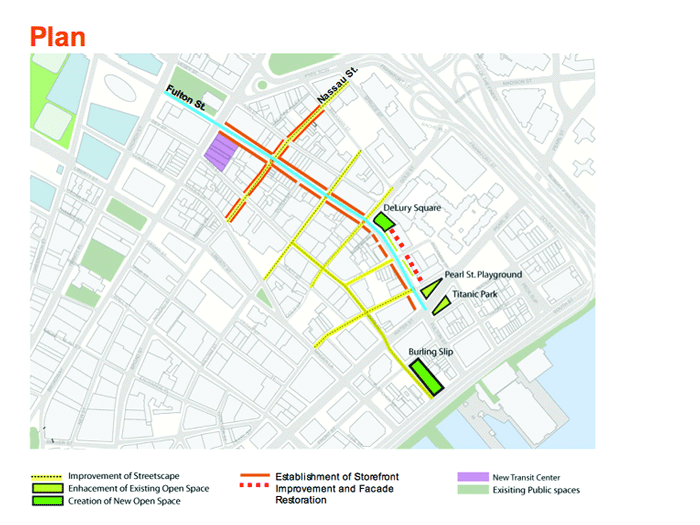By Janet Kwon
The city has expanded long-awaited plans to add park space and better storefronts to Fulton St., although construction on all parts of the project will not begin for several years.
Amanda Burden, chairperson of the Dept. of City Planning, though, told Downtown Express that things are “moving very very rapidly,” now that the money has been approved by the U.S. Dept. of Housing and Urban Development.
The $38 million plan will begin an environmental review this fall, and while construction for certain elements of the plan is slated to begin fall 2007, construction for other parts may not start until 2009.
In addition to refurbishing the length of Fulton St., the updated plans now include renovating streets that sprout from Fulton — Nassau, William, Gold, Cliff, Pearl and John Sts. Fulton St. is being extended through the World Trade Center site, which will make the street the only direct connection between Battery Park City and the East River.
“Honestly, when you’re on Broadway, you’re not invited to walk down the street — it’s not inviting to walk down Fulton,” Burden said in a telephone interview. But after the storefronts and sidewalks are revamped and new lighting is added, “it should be one of the most fabulous walks in the city and it will be.”
In a presentation to Community Board 1’s Seaport/Civic Center Committee, Keith O’Connor, a Lower Manhattan senior planner with City Planning, told the board members and residents that in addition to these streetscape improvements, building facades along a stretch of Fulton St. will also be restored and improved. Construction for this phase of the project will likely begin in 2009.
“Construction will be phased based on the completion of the environmental review and ULURP (Uniform Land Use Review Procedure), as well as to coordinate construction with the other various projects planned for Fulton St. — transit hub, W.T.C. site and other streetscape improvements,” said Rachaele Raynoff, a City Planning spokesperson.
Also, the current Fulton St. plan boasts a new playground at Burling Slip, which will be designed by Rockwell Group, who will be working on the project pro bono. Construction for this playground, as well as upgrades and enhancements for the existing Pearl St. playground and the Titanic Memorial Park near Water St. is predicted to begin late 2007. The city had planned to build an apartment building on the Pearl St. playground but changed the plan after C.B. 1 raised objections.
Rockwell Group presented their ideas and philosophy behind creating a “play space” in Burling Slip that both parents and children can enjoy. However, because this was the first time the community was presented with this idea, the firm waited for community response before beginning the design process.
In addition to $38 million from the Lower Manhattan Development Corporation (approved by HUD), City Department of Transportation is also dedicating $5 million of its Federal Highway Administration funds to the project.
The community reaction to Burling Slip was positive, with the general consensus being that the neighborhood needs more space for children to play. It will take at least 18 months to begin construction on the playground, said Lawrence Mauro, a project manager for the City Department of Parks and Recreation. The 215-ft. by 70-ft. playground will be funded with the $38 million L.M.D.C. money, and Rockwell Group said they are exploring ways to raise private funds to match public funds for the project.
Committee member Linda Roche wondered if certain parts of the plan would suffer to make way for the updates of the plan.
O’Connor answered Roche with a resounding “no,” and assured her that the agencies involved are doing the most they can with the money they have.
“I’m taking him at his word,” Roche said of O’Connor’s response. “I’m just happy to see that they’re working on it… the park over at Burling Slip will be a great amenity to the community,” she added.
Board member Marc Donnenfeld, however, feels that expanding the project could mean a shortage of money.
“They expanded the scope of the job, and generally when you do that, you always need more money,” Donnenfeld said, adding, “You put paint on the wall, and if you’re going to paint a bigger wall, you need more paint.”
The Fulton St. reconstruction project grew out of Mayor Bloomberg’s 2002 vision to revive Lower Manhattan.


































